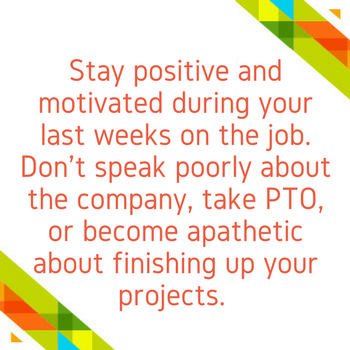71a875c210f5678e9791ff0a00774848.jpg?sfvrsn=ee189d3d_3)
Quitting a job can be difficult, especially if you've had a positive experience and will miss your coworkers and the organization. But even if you don’t have warm and fuzzy feelings about your soon-to-be-former employer, it’s important to leave on the best terms possible.
Why? Because it gives you options: You might want your boss or a coworker to remain a mentor; there’s a possibility you’ll need a reference down the road; or you might even eventually want to come back as an employee or take on freelance work from the company. Plus, it can only boost your professional brand to have positive word of mouth about your work from a former employer. Here are six steps to take when it’s time to turn in your resignation.
1. Set Up a Meeting With Your Manager
Send your supervisor a meeting invite or set up a time to talk—you'll avoid catching your boss off-guard by alerting him or her that you need to have a more formal conversation. Prior to the meeting, come up with a few important experiences you’ve had while working there, in addition to why you have decided to move on. Stay positive with these remarks, i.e., the new position presented an opportunity to take on more responsibility, learn a new skill or pivot your career. Thinking this through ahead of time will ensure that you’re prepared with answers that keep the tone of the meeting positive. End the discussion by expressing gratitude for the opportunity to work there.
2. Write a Formal Letter of Resignation
After informing your boss, send a formal letter of resignation via email. Since HR needs to be aware of this as well, so address the letter to your boss, and copy HR on it. This letter should include the position you are resigning from, the reason you are leaving, the date effective and a message of appreciation. Be sure to send this letter at least two weeks prior to resigning, or further in advance if you are in a management position.
3. Tidy Up Loose Ends
Now that you have officially put in your notice, it’s time to organize your work and finish projects that can be completed before you leave. For the projects you won’t have time to complete, leave detailed instructions about what needs to be done, who to contact, where files are located, passwords, timelines, etc. It's also a good idea to notify project stakeholders that you are leaving and possibly even suggest a replacement for your role. If there is time, offer to train your replacement.
4. Maintain a Positive Reputation 
It’s critical that you stay positive and motivated during your last few weeks on the job. Don’t speak poorly about the company you are leaving, take PTO during your final weeks, or become apathetic about finishing up your final projects. Maintaining a strong reputation throughout your entire time at the company will only help you in the future.
5. Say Goodbye
For those who prefer to fly under the radar, it can be tempting to ghost on your last day, but it’s in your best interest to resist the temptation. Instead, give some sort of formal goodbye to the people you have worked with. Whether it’s in person at an all-staff meeting or online via email or Skype, a public statement and thank you is the best way to end on good terms. Include your personal email or phone number and encourage coworkers to keep in touch!
6. Handle the Exit Interview With Grace
Most organizations will ask to have an exit interview before your last day. This meeting, which will most likely be with HR, will consist of lots of paperwork, but it’s also your chance to share constructive feedback with the company. Prepare for the session by working through your emotions beforehand and focusing on facts while in the interview. Make sure to be positive and stay away from venting personal grievances. Once you’ve completed your exit interview, let it go. It’s time to move on to the next chapter in your career!
Get career advice like this right in your inbox with CompTIA’s IT Career Newsletter. Subscribe today.


90a875c210f5678e9791ff0a00774848.jpg?sfvrsn=46f9b923_3)

0